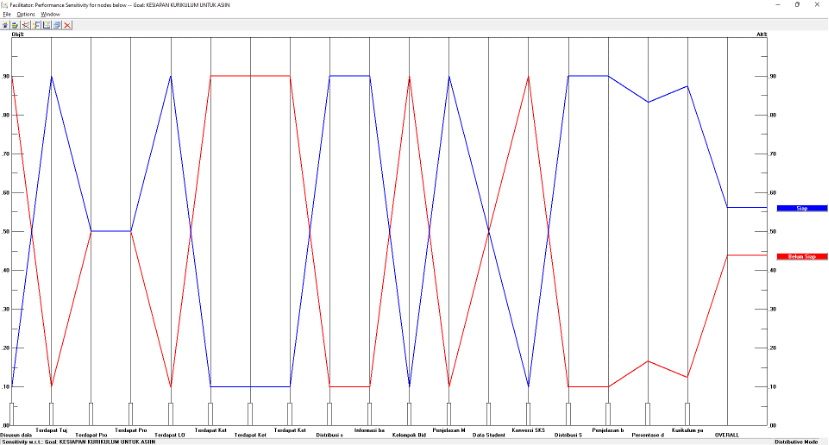Reviewing curriculum towards ASIIN international accreditation using analytical hierarchy process
DOI:
https://doi.org/10.12928/bamme.v3i1.9551Keywords:
analytical hierarchy process, ASIIN, curriculum, international accreditationAbstract
This research focuses on studying the curriculum of three study programs at the Faculty of Science and Technology, namely Biology, Informatics Engineering and Architectural Engineering. The purpose of this research is to see how ready the curriculum of the 3 study programs is to be submitted as ASIIN international accreditation material. The method used to measure curriculum readiness is using AHP. The results of this study are that from 3 study programs that have been assessed using AHP, the study program that is most ready for its curriculum is Informatics Engineering with a readiness of 73.4%, followed by Architectural Engineering, and after that Biology.
References
Asmawi, M. R. (2005). Strategi Meningkatkan Lulusan Bermutu di Perguruan Tinggi. Makara Human Behavior Studies in Asia, 9(2), 66–71. https://doi.org/10.7454/mssh.v9i2.124
Bornmann, L., Mutz, R., & Daniel, H. D. (2013). Multilevel-statistical reformulation of citation-based university rankings: The Leiden ranking 2011/2012. Journal of the American Society for Information Science and Technology, 64(8), 1649–1658. https://doi.org/10.1002/asi.22857
Daraio, C., Bonaccorsi, A., & Simar, L. (2015). Rankings and university performance: A conditional multidimensional approach. European Journal of Operational Research, 244(3), 918–930. https://doi.org/10.1016/j.ejor.2015.02.005
Dodevska, Z., Radovanović, S., Petrović, A., & Delibašić, B. (2023). When Fairness Meets Consistency in AHP Pairwise Comparisons. Mathematics, 11(3). https://doi.org/10.3390/math11030604
Karczmarek, P., Pedrycz, W., & Kiersztyn, A. (2021). Fuzzy Analytic Hierarchy Process in a Graphical Approach. Group Decision and Negotiation, 30(2), 463–481. https://doi.org/10.1007/s10726-020-09719-6
Kędzior, A., & Kułakowski, K. (2022). Multiple-criteria Heuristic Rating Estimation.
Latifah, S. (2005). Prinsip-Prinsip Dasar Analytical Hierarchy Process. https://api.semanticscholar.org/CorpusID:146654904
Liu, F., Zhang, J.-W., Zhang, W.-G., & Pedrycz, W. (2020). Decision making with a sequential modeling of pairwise comparison process ✩,✩✩. 195, 105642. https://doi.org/10.1016/j.knosys
Liu, Y., Eckert, C. M., & Earl, C. (2020). A review of fuzzy AHP methods for decision-making with subjective judgements. In Expert Systems with Applications (Vol. 161). Elsevier Ltd. https://doi.org/10.1016/j.eswa.2020.113738
Nedashkovskaya, N. (2022). Comparison Analysis of Prioritization Quality Criteria Using Paired Comparison Method of Prioritization. 2022 IEEE 3rd International Conference on System Analysis and Intelligent Computing, SAIC 2022 - Proceedings. https://doi.org/10.1109/SAIC57818.2022.9923027
Pratiwi, D. A., Purwanggono, B., & Bakhtiar, A. (2017). Harmonisasi Indikator Kinerja UNDIP (IKU) Dengan Kriteria World Class University QS World Rankings. Industrial Engineering Online Journal, 6(1), 1–11.
Saaty, R., & Mu, E. (2022). T.L. Saaty Decision Making for Leaders Hackathon. International Journal of the Analytic Hierarchy Process, 14(1). https://doi.org/10.13033/ijahp.v14i1.987
Saaty, T. L., & Katz, J. M. (1994). Theory and Methodology Highlights and critical points in the theory and application of the Analytic Hierarchy Process. In European Journal of Operational Research (Vol. 74).
Salmi, J. (2009). The Challenge Of Establishing World-Class Universities. World Bank Publications.
Stofkova, J., Krejnus, M., Stofkova, K. R., Malega, P., & Binasova, V. (2022). Use of the Analytic Hierarchy Process and Selected Methods in the Managerial Decision-Making Process in the Context of Sustainable Development. Sustainability (Switzerland), 14(18). https://doi.org/10.3390/su141811546

Downloads
Published
Issue
Section
License
Copyright (c) 2023 Angga Dwi Mulyanto, Dwi Suheriyanto, Akyunnul Jannah, Tarranita Kusumadewi, Sri Harini, Elly Susanti

This work is licensed under a Creative Commons Attribution-ShareAlike 4.0 International License.
Authors who publish with this journal agree to the following terms:
- Authors retain copyright and grant the journal right of first publication with the work simultaneously licensed under Creative Commons Attribution License that allows others to share the work with an acknowledgement of the work's authorship and initial publication in this journal.
- Authors are able to enter into separate, additional contractual arrangements for the non-exclusive distribution of the journal's published version of the work (e.g., post it to an institutional repository or publish it in a book), with an acknowledgement of its initial publication in this journal.
- Authors are permitted and encouraged to post their work online (e.g., in institutional repositories or on their website) prior to and during the submission process, as it can lead to productive exchanges, as well as earlier and greater citation of published work (See The Effect of Open Access).



